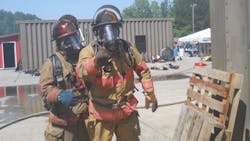In many businesses, in the fire service, and, particularly, in supervisor and officer development programs, the concepts of being a teacher, a mentor and a coach are blurred, at best, but usually are fused into one generic concept. In truth, these all are very distinct ways of allowing personnel to enhance their performance, and when mentoring is done correctly, it can lead to an engaged, happy and highly productive workforce.
People are brought to us off of the street or are promoted through the ranks with the hope of becoming the best version of themselves in this career. Obviously, in the fire service, new hires and new officers have the goal or vision of becoming an independently functioning firefighter and/or officer. Most of our personnel will make it, but recruits, probies and journeymen all are particularly in need of mentorship. Even your newly promoted personnel need some form of mentorship, but it looks quite different because of the level of experience that the officers should have.
If you more deeply examine the mentorship role and relationships at your stations, you can better understand how this directive relationship can help personnel at all levels to succeed in ways that aren’t addressed strategically in current development systems.
Mentor origins
The idea of a mentor is far from a new concept, relationship or idea. One of the oldest references to the idea of mentors comes from ancient cave paintings that date back to about 12,000 B.C. Paintings in France show older hunters taking younger hunters on what appear to be an educational tour on how to hunt. In some circles, it is believed that the word “mentor” might have come from the idea of these early “men tours.”
Another early reference to a mentor is seen in the ancient tribes and cultures of Africa. This style of mentoring can correlate to the phrase, “It takes a village.” In ancient Africa, villagers would share the responsibilities of raising children, but the more specific element to this process involves how an older child was assigned to a younger child to help guide the younger child through development. This growth and guiding process involved a lot of question-asking.
The term “mentor” first was chronicled in ancient Greece. This first written reference to a mentor can be cited in the “Iliad,” when Ulysses leaves his son, Telemachus, in the care of Mentor, who is an older Greek man who is to teach Telemachus about being Greek. Ulysses then leaves for a 10-year war in Troy, and it’s Mentor who is to prepare Telemachus to lead Ulysses’ kingdom upon Ulysses’ death. Mentor fails at his job, and Ulysses’ kingdom fails to thrive, and a goddess intervenes to set things right. Even so, she takes on the visage of Mentor to fix the issues.
It also is of note that, throughout the ages, mentorship has been akin to apprenticeship. It is known that Hammurabi’s code makes a decree that older artisans are to teach their craft to the next generation. In ancient Rome, many of the trades were performed by slaves, but as the centuries passed, the Romans developed the independent collegia and began to “industrialize” the process of training citizens in a craft or trade.
As certain guilds, trades and industries developed through the centuries, apprenticeships became the primary pathway for the youth to learn a specific skill or trade. This continued until the early 20th century, when the advent of assembly lines and modern factories diminished the need for a “skilled” work force. Because of the time that was needed in apprentice programs to skill a worker in a craft, many companies moved away from the concepts of apprenticeships and mentoring.
Teaching mentors
Mentorship now is defined as a strategic approach to developing employees by pairing them with more experienced people—the mentors—who will teach, counsel, sponsor and encourage by teaching and using their own experience and those experiences that they observe. Mentorship is a directive process of teaching and showing novice learners about the trade that they committed their life to.
The issue that most modern organizations fail to understand is how to prepare mentors to properly coach and teach those whom they are assigned. The story above about Mentor and how he failed to prepare Telemachus to be king echoes this idea. Ulysses chose Mentor simply because he is an older Greek man. It is unclear whether Mentor has any knowledge of how to prepare Telemachus to be king.
Most people who are in senior positions in the fire service are there because of their knowledge, skills and abilities at the job. As senior members, most typically get quick classes on what the organization expects as the outcome for those who are being mentored, but the mentors rarely are taught how to lead and coach on performance enhancement. The issue with the newer generation of firefighters is that they are accustomed to instantaneous results, so it’s paramount that the mentors of today be a professional firefighter who not only is skilled in firefighting but in mentoring and coaching. If you don’t teach your mentors to be patient with these green recruits, who might not be patient with the process of becoming a firefighter, then your process will falter.
The key to making this work is teaching mentors how to ask questions. The recruits have so much information from the academy, but they need to turn this knowledge into usable skills.
Our newer students’ experiences also are becoming more virtual, and their educational experiences lack the critical thinking skills of old. Modern textbooks are filled with facts, and evaluations are filled with multiple-choice tests that don’t promote deeper thought into ideas and thoughts of concepts. Institutions want students to get done with their programs and use multiple-choice testing to move them efficiently through schools and academies. This means there rarely is time to delve into concepts and ideas in a way that allows students the personal freedom to know what they know and why they know it. Therefore, mentorship is critical for modern businesses.
Once the cognitive onload has been completed in training, it’s the role of the first-station assignments to unpack the material. Being able to demonstrate a skill is incredibly important, but it’s the ability to articulate why we do it and the way that we do it that leads to mastery of the skill.
That said, mentoring involves different skills than instructing, teaching, coaching or even counseling. Again, most organizations promote supervisors because of their cognitive and psychomotor skills or their success directing people, such as on the fireground. Mentoring can seem like a more comfortable relationship, because it involves directing skills that a new firefighter or newly promoted individual must learn.
What we typically miss in supervisory development programs is the soft skill development that is crucial in mentorship. Even though mentorship is based on directing an employee’s growth, much like directing personnel on a fire scene, a successful mentorship program only can occur if it doesn’t activate the defense mechanism in the learner. If we are going to assign personnel to fulfill this role, we must do mentorship training. Assuming that a seasoned firefighter or officer simply has the skills to teach and mentor because of that individual’s status is a recipe for disaster.
Many police departments have field training officer (FTO) programs that send the FTO to training classes on instruction and coaching. A good FTO mentor-based program involves questioning students on what they observed during the first few months. As students progress, the FTO creates opportunities for the students to make decisions while the mentor observes. There then is a new set of questions that arises, which aims to get students to critique their performance. This creates learning experiences that students can draw on for their career. Eventually, the FTO is the observer and only interjects when something is missed or if safety issues arise.
We, as instructors, mentors and coaches, want to pass on our experiences to others in the hope that they will glean some learning from it, just as we did when we experienced it, but this isn’t learning. Students don’t have this experience in their memories. They can appreciate the interaction, but it isn’t learning. The story stays in their brain totally disconnected from any experience that the students had. There is no memory of action associated with it. A well-timed story to illustrate a point is useful in a class, but we all know that a class of stories is of no benefit to the learner. The best story is one that the students experience, whether in training or in the field.
Demonstration
Another good idea for training is good demonstration for initial learning. When a perfectly choreographed demonstration is performed, students have an opportunity to work to emulate the observed motions, and good coaching instructors and mentors will ask all of the right questions to help students understand these new memory experiences gained on the drill ground or in the field. This incorporates the sights, sounds and even feelings that students have during the experience.
To raise personal awareness of the mind-body connection following demonstration involves getting students out of their conscious mind, which is where judgmental thoughts occur. These conscious-mind/judgmental thoughts aren’t constructive to learning, in the same way that an overload of instruction isn’t. The brain has a great deal more neuroplasticity than we give it credit for, even in later years of life, but it’s the negative judgments of the conscious mind that conflict with the natural learning process.
A baby doesn’t need to attend an academy, conference or lecture to learn how to walk. The baby observes the “experts” in their environment and then, through a process of natural learning and experimenting, will crawl, walk and then run. Most parents aren’t critical of babies as they learn, but they are encouraging as coaches and mentors. As we get older, we become more critical of ourselves and each other, which is destructive to this natural learning process.
This is key with the younger generations because, as noted above, their experiences are very synthetic. It’s extremely important to have mentors who can engage and encourage in a powerful mentorship process to shape the newer generations’ field experiences in a dynamic fashion. Again, this isn’t a comfortable space for us to work from because, if we are honest with ourselves, we typically just “pour” information into our students rather than asking questions to help them learn from an encounter. Of course, there must be a cognitive element for any new skill, but we put a lot of emphasis on this area since it’s easy to test and verify.
The issue is that any knowledge, or synaptic change in the brain, dissipates without an experience tied to it. The longer that any knowledge sits in the brain and isn’t reinforced with experiences, the more that it will become useless until it’s forgotten, as the brain makes space for newer material. When called on for actual use in high-risk/low-frequency situations, we won’t be able to react properly and in the way that we are expected.
Mentoring, when done well, can unpack the material and return to it in a way that pulls information from learners and helps them to remember what might have started to dissipate.
Evolution of the relationship
Another component of mentoring is how the relationship comes into being. Many people promote mentorship as an organic process that just happens or is only effective if we seek it as the learner. Mentorship and apprenticeships throughout history have been just as effective when the people who are designated as a learner are assigned to a mentor. This still is true today. Mentors who have been trained to coach and use experience-based instruction for those who are assigned to them can be extremely effective. The key is to quickly build trust. People who mentor must understand the nature of their relationship as it fits into coaching and management, and understand the goal they seek to accomplish with the employee, particularly at the probationary level.
I coach at a local university in an executive program. The students are assigned coaches if they don’t have someone specific who they want to utilize. (Surprisingly, most students don’t request a coach but allow the staff to pair them.) This is done by looking at personality styles and career paths and interests. Even though I have a certificate for managerial coaching from this university, we all attend a training class prior to the launch of each program in the fall. This training helps prepare us for the coaching process and the timelines that are used by this executive business program.
Later, during the summer semester, all of these students are assigned a mentor from an outside mentorship agency. This is done primarily based on career paths but also through a mentorship compatibility survey that the students complete. The students can transition to a mentor for the remainder of their program, but they have the option to do both. Half of the students who I coached did both. It is from these discussions that I see how the mentorship relationship has important differences. This relates to how the mentors goal-set for the students, as opposed to the coaching role, which involves a lot of goal-setting by the student. Regardless, the system works well because of the training that the mentor company provides to the mentors.
It is important that mentors who don’t buy in to the culture of the organization and their role in the process be removed from the mentorship role. They can destroy everything that has been done during the recruit school process. The mentor must be your most highly trained and experienced personnel on the job. An inexperienced mentor is useless. You lose credibility when you assign or allow new personnel to work with mentors who lack the experiences to back up their instructional abilities.
You also must ensure that the mentor is able to teach in the non-judgmental way noted above, and all of this doesn’t happen by accident. It takes training and strategic planning. There are very few organizations who have this kind of mentoring, mentorship selection and training for their people in these roles.
Understand the role
It’s important to realize that it isn’t our role to teach but to help students to learn, specifically from their experiences. As mentors or coaches, we often can be the source of a lot of unhelpful dialogue to the performer when teaching because of the instructions that we give, rather than asking the right questions.
People look at themselves in a judgmental way, which interferes with their potential to perform at their best level. People have more potential than they believe that they do, but they also interfere with that potential more than they would like to admit. It’s our role to inspire self-trust in the person we are mentoring and coaching.
In classical learning pioneered by the Greeks, it was their view that all learners have the knowledge and potential within them. It was the role of the mentor or teacher to bring this out. They didn’t pour knowledge into their students but used questions to make them think. This type of learning and employee growth can happen again by leveraging the strength of experience-based learning through a well-trained mentoring cadre who understand the role they play, have the necessary tools to take personnel to that next level, and know the timelines that are expected by the organization.
James O'Shields
James O’Shields is a 20-year veteran of the fire service and serves as a captain for Cobb County Fire and Emergency Services. He is a paramedic who is assigned to Truck 1 in Mableton, GA. O'Shields has a bachelor’s degree in psychology and a master’s degree in business administration from Kennesaw State University (KSA). In 2016, he completed the Certified Managerial Coaching Program through KSA’s College of Continuing Education. O'Shields coaches and mentors with Cobb Fire, in the KSU EMBA program and with Cobb County Human Resources Supervisory Programs. He has taught at the National Fire Academy with the 21st Century Training for Fire and EMS Training Officers and also teaches on the concepts of feedback, coaching, mentoring and teaming with Cobb County Human Resources and around the county.






